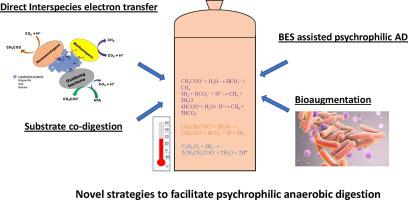Waste Management ( IF 8.1 ) Pub Date : 2021-07-16 , DOI: 10.1016/j.wasman.2021.07.002 Bikash R Tiwari 1 , Tarek Rouissi 1 , Satinder Kaur Brar 2 , Rao Y Surampalli 3

|
Anaerobic digestion (AD) under psychrophilic temperature has only recently garnered deserved attention. In major parts of Europe, USA, Canada and Australia, climatic conditions are more suited for psychrophilic (<20 ℃) rather than mesophilic (35 – 37 ℃) and thermophilic (55 – 60 ℃) AD. Low temperature has adverse effects on important cellular processes which may render the cell biology inactive. Moreover, cold climate can also alter the physical and chemical properties of wastewater, thereby reducing the availability of substrate to microbes. Hence, the use of low temperature acclimated microbial biomass could overcome thermodynamic constraints and carry out flexible structural and conformational changes to proteins, membrane lipid composition, expression of cold-adapted enzymes through genotypic and phenotypic variations. Reduction in organic loading rate is beneficial to methane production under low temperatures. Moreover, modification in the design of existing reactors and the use of hybrid reactors have already demonstrated improved methane generation in the lab-scale. This review also discusses some novel strategies such as direct interspecies electron transfer (DIET), co-digestion of substrate, bioaugmentation, and bioelectrochemical system assisted AD which present promising prospects. While DIET can facilitate syntrophic electron exchange in diverse microbes, the addition of organic-rich co-substrate can help in maintaining suitable C/N ratio in the anaerobic digester which subsequently can enhance methane generation. Bioaugmentation with psychrophilic strains could reduce start-up time and ensure daily stable performance for wastewater treatment facilities at low temperatures. In addition to the technical discussion, the economic assessment and future outlook on psychrophilic AD are also highlighted.
中文翻译:

对嗜冷厌氧消化的重要见解:提高沼气生产的新策略
低温下的厌氧消化 (AD) 直到最近才受到关注。在欧洲、美国、加拿大和澳大利亚的大部分地区,气候条件更适合嗜冷(<20 ℃)而不是中温(35 – 37 ℃)和嗜热(55 – 60 ℃)AD。低温对重要的细胞过程有不利影响,这可能会使细胞生物学失活。此外,寒冷的气候也会改变废水的物理和化学性质,从而降低微生物底物的可用性。因此,使用低温驯化的微生物生物质可以克服热力学限制,并通过基因型和表型变异对蛋白质、膜脂组成、冷适应酶的表达进行灵活的结构和构象变化。降低有机负荷率有利于低温下产甲烷。此外,对现有反应器设计的修改和混合反应器的使用已经证明在实验室规模中提高了甲烷的产生。本综述还讨论了一些新的策略,如直接种间电子转移 (DIET)、底物共消化、生物强化和生物电化学系统辅助 AD,这些策略具有广阔的前景。虽然 DIET 可以促进不同微生物的同养电子交换,但添加富含有机物的共底物有助于在厌氧消化器中保持合适的 C/N 比,从而提高甲烷的产生。使用嗜冷菌株进行生物强化可以减少启动时间并确保污水处理设施在低温下的日常稳定性能。除了技术讨论之外,还强调了嗜冷性 AD 的经济评估和未来展望。



























 京公网安备 11010802027423号
京公网安备 11010802027423号